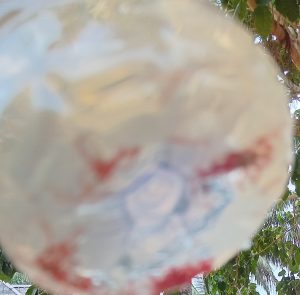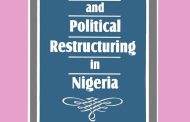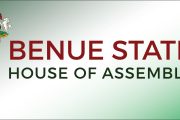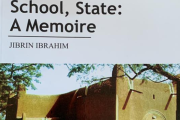37 years after a horrific cholera outbreak in the Opialu community in Okpokwu Local Government Area of Nigeria’s Benue State, it is under siege again from an unknown parasites(?). Opialu, a community of five segmented but contiguous villages is estimated in some quarters to have lost about 86 persons to the 1988 cholera. This time, a reddish wormy swarm of parasites(?) is all over in the community’s section of River Ogbadibo.
There is nothing to suggest though that this is restricted to Opialu community alone as the details below suggest that no less than three other such communities might also be at risk.
Although Mr. Inalegwu Ada, the elected Chairperson of the Okpokwu Local Government Council who responded promptly on the issue when called on the phone Saturday, April 12th, 2025 said the council received no reports from Opialu or any other villages around the area about the strange invasion, Intervention understood that Akpodo, Akpoga, Ojigo and a few more villages in the lower part of Edumoga District shared one of the features in the sequence to the current situation at Opialu.

Check them out in the white clusters
The sequence narrated to Intervention is that Opialu experienced the first rain for the year on March 19th, 2025. The following day, there was observed a flood of mostly or largely dead fishes all over the water. Many of the villagers helped themselves to the unexpected loot. This experience is not restricted to Opialu as several other communities on the waterway also had their own share of the flood of dead fishes. Akpodo, another huge community almost in the demographic stature of Opialu, is one of them.
A week or so, those who claim to have been observing the sequence of developments in question told Intervention that spirogyra looking stuff could be seen all over the river. Subsequently, the red, wormy living things were noticed.
Screenshots of a portion of the river taken by Intervention showed large numbers of them very visible to the eye. Four hours after the first screenshots, the wormy parasites(?) were observed to be still restless in the bottled water container before the water was turned into a plate. Nothing of this had changed as at midnight April 12th, 2025 when this report was being compiled into a post.
No infections traceable to the wormy parasites(?) have been made anywhere but there is apprehension in the community. For one, the wormy invasion is so massive in terms of presence. Two, although River Ogbadibo around the area is said to have been changing color, no such wormy creatures have ever been sighted. Three, there is total confusion about where the creatures might be coming from and how best to respond to it.
Two theories are most common. Processing of raw cassava into garri is what defines the economy of Opialu, just like the entire Edumoga District, the largest single of the 22 districts in the old Idoma Native Authority. There is something like a channel through which the water from the garri making process eventually empties into the community’s section of the river. The second and the more pervasive theory is that the avalanche of dead fishes on March 20th, 2025 occurred as a result of one of the unauthorised fishing practice involving the use of Gammalin-20.
Although he is not a medical doctor, Mr. John Ojabo, the chairman of the Opialu Community Development Association (OCDA) challenged the violent fishing practice theory. He told Intervention that Gammalin-20 does not lead to partly dead fishes as seen on March 20th, 2025. “What Gammalin-20 does is to intoxicate the fishes as to lose control of themselves and be very vulnerable to be caught. The fishes seen here that time came half dead or somehow dead. That is why even women and children could easily pick two, three basins within so short a time. That is not how Gammalin-20 works”.
He has more supporters than those who pose the garri theory although Mr. Ojabo is not as interested in whatever causes the strange invasion. He advances a completely different argument which is that whether the wormy invasion came from garri processing or Gammalin-20, the river does not provide safe drinking water for the Community anymore if ever it did. All sorts of dirtiness flow from those bathing and drinking from the villages and communities at the source of the river down to Opialu and further down to those communities after Opialu.
Again, he has got supporters than critics on this, As Ralph Adeka, a community leader in Opialu observed, the users have outnumbered the river. Others say that the river carries all sorts of dirtiness from people washing their dresses to people throwing in aborted children. “So, it is just not a safe drinking water”, said a retired teacher.
As seemingly clear headed as the youngish community chairman, he doesn’t appear that clear in terms of a coordinated community response. Or, to put it better, he is still thinking through the plausible options the community leaders are considering. One is to get the town crier to work to announce outright banning of fetching water from River Ogbadibo. Two, get the town crier to announce boiling of water up to kill the invaders.
Each of these options can create its own panic crisis, with consequences far worse than imagined. So they are still thinking as at Saturday, April 12th, 2025.

When seen from a screenshot of them in a bottled water container
What OCDA is clear about is the imperative of immediate intervention of the Federal Government. Why Federal Government? Chairman Ojabo does not think the state and the Local Government have got the level of material resources to respond to Opialu’s history of vulnerability to epidemic, readily citing the number of deaths recorded in 1988. The consciousness of historical vulnerability appears well spread in Opialu. As much as the community appreciates what is obviously an extensive renovation of a community clinic at Opialu, for instance, there is a sense in which the clinic is considered to fall short of what is required and this grounded in the felt sense of historical vulnerability too.
It was understood that two members of a family at Opialu who have felt the inappropriateness of the river serving as community source of water supply have dug a borehole. Somehow, the borehole has not been put to use for whatever reason(s).
Children told Intervention they see the wormy on their hairs/head after bathing in the river. Nature worked in a way that the river spreads itself in such a manner that each of the five segments of Opialu is well served by it. Right now, the wormy creatures are not concentrated evenly. Some sections of the community even said they have not seen the biological creatures even as the fear is that they are still multiplying and the community might simply be at risk sooner than later.
Some people are responding to the development by no longer drinking water from the river. Others are resorting to ‘Pure Water’, the price of which has shot up to 700 Naira for a bag of 20 sachets.
These are three rivers that serve the water supply function in much of the communities in the LGA. These are rivers Ogbadibo, Ogege and Okpokwu.
Intervention failed woefully to speak to Mrs Maria Idu, the head of the UNICEF team that contained the 1988 cholera outbreak in Opialu and if there were any background details helpful to dealing with the new situation. The networks were hopelessly unhelpful in terms of calling from Opialu where the reporter then was.
What is clear is the poverty of community health intelligence from the rural areas across Nigeria. Stuff could be happening for months without any level of authority detecting it, not to talk of responding to it. In certain cases, UNICEF or WHO gets to know before local authorities. In this case, no level of authority is aware. Within the community itself, awareness is only just reaching alarm level.




























